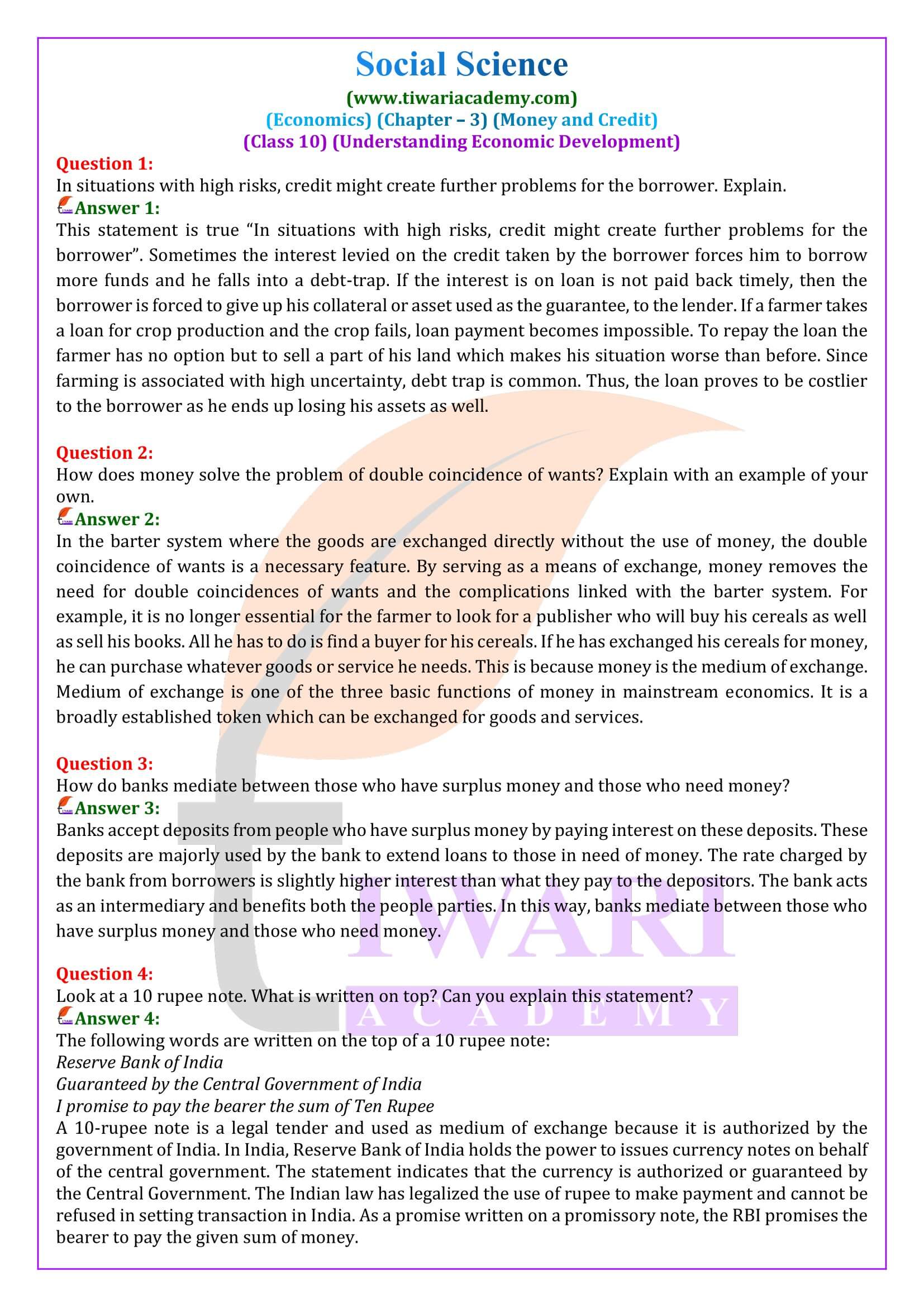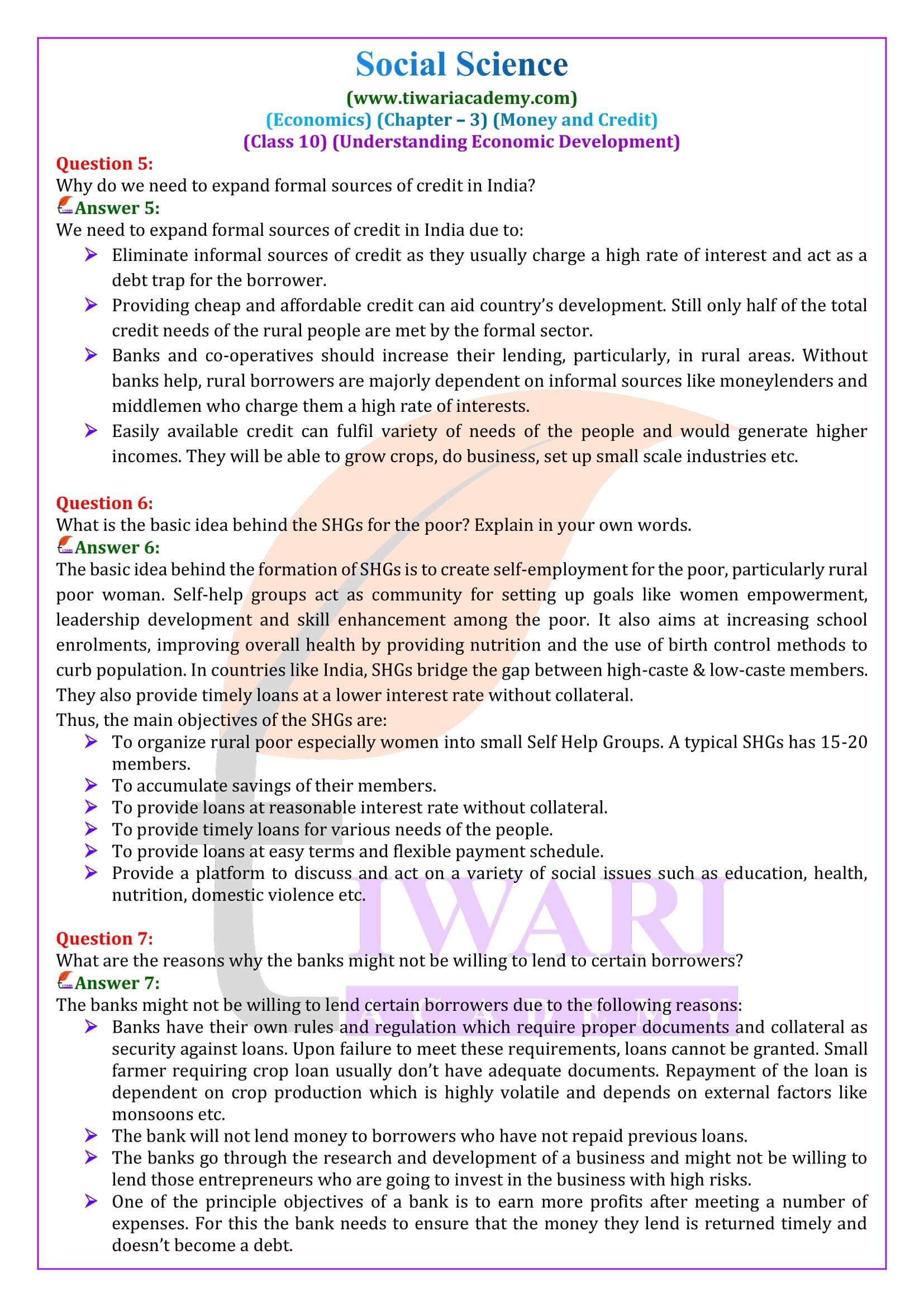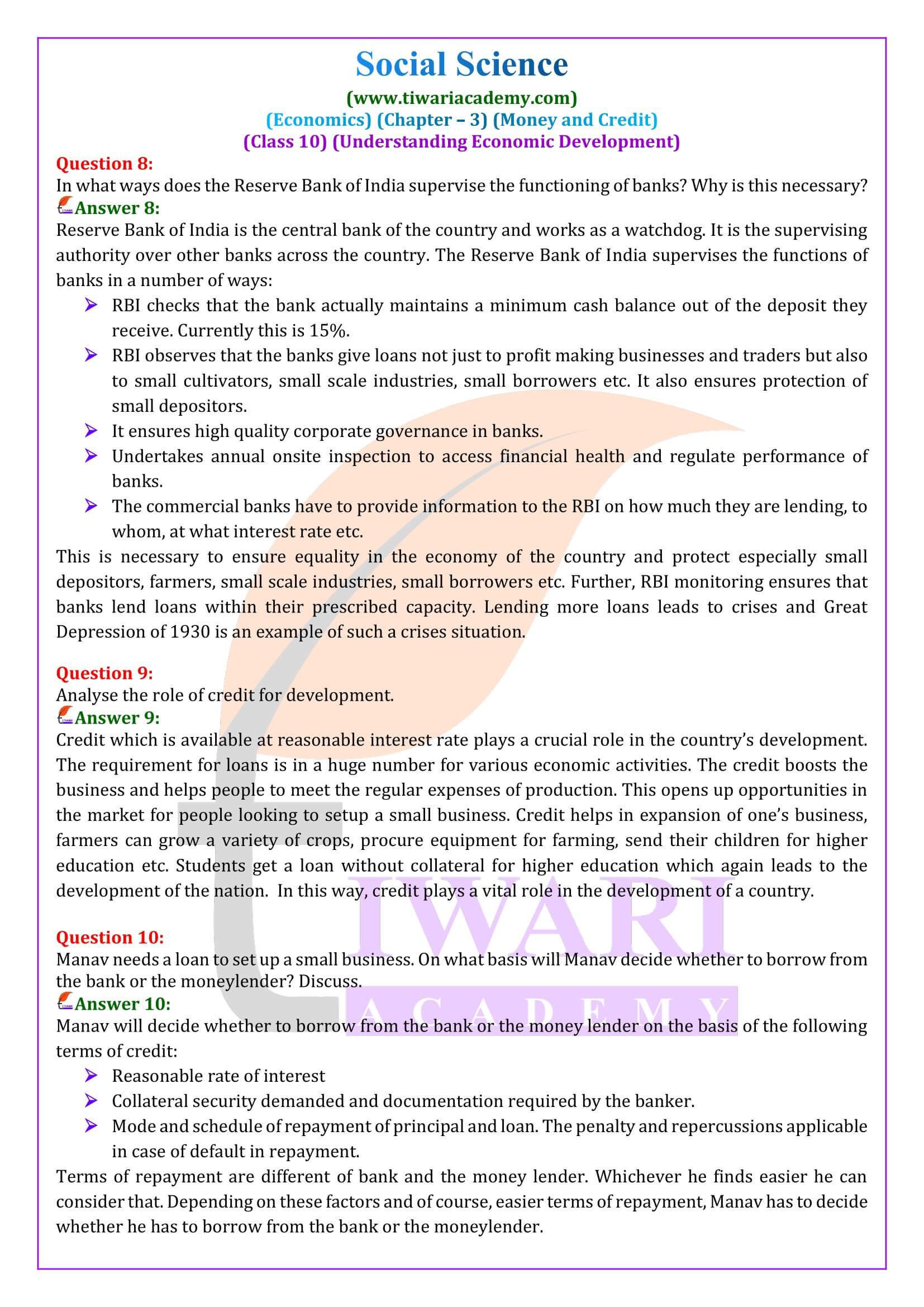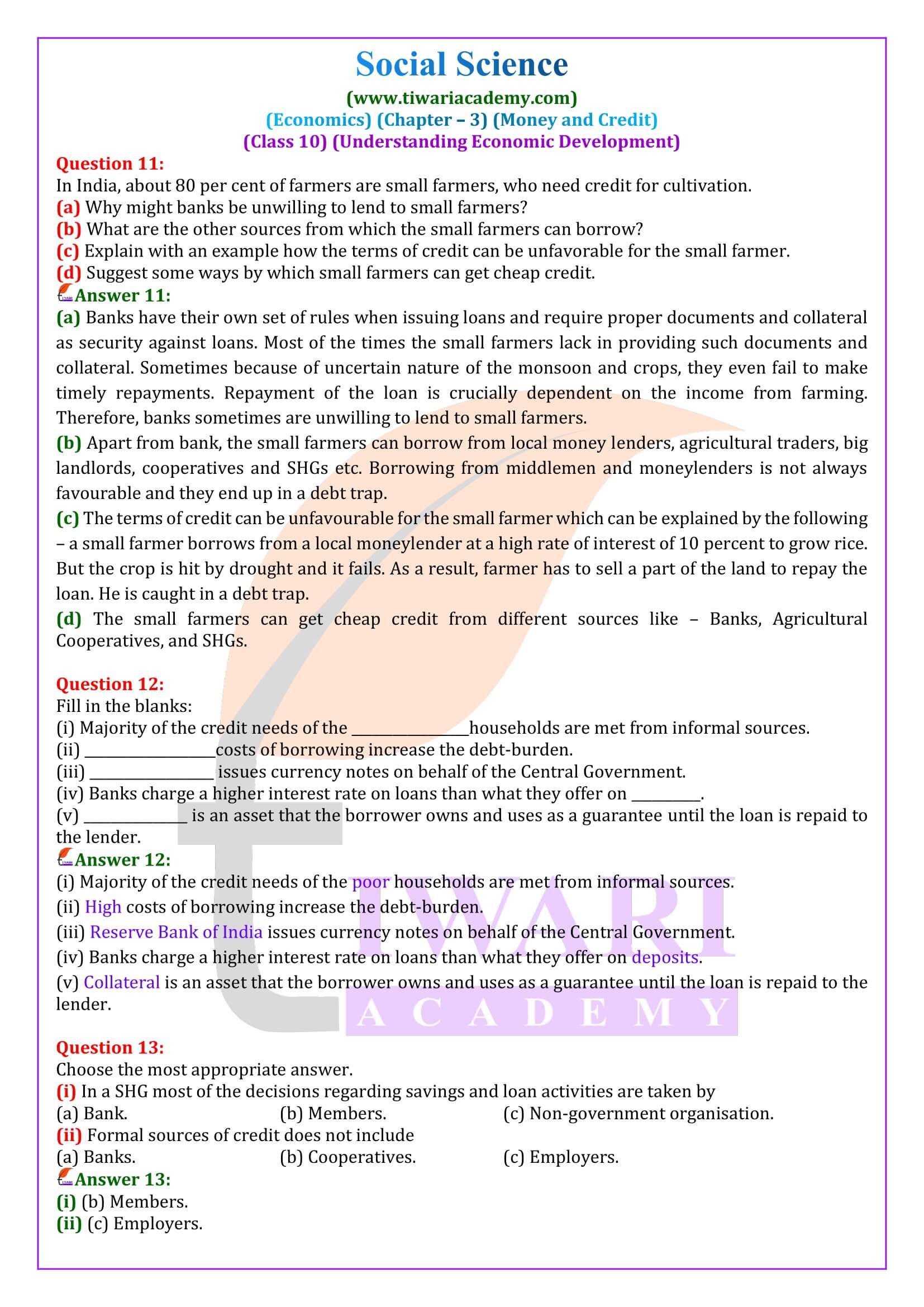NCERT Solutions for Class 10 Economics Chapter 3 Money and Credit in English and Hindi Medium updated for academic session 2025-26 along with important questions, MCQ and one marks extra questions. Download Class 10 Offline apps to use it without internet. Ask your queries in Discussion Forum and get the proper answers by experts and other users.
NCERT Solutions for Class 10 Economics Chapter 3
| Class: | 10 |
| Subject: | Social Science – Economics |
| Chapter 3: | Money and Credit |
| Academic Session: | 2025-26 |
Class 10 Economics Chapter 3 Money and Credit
NCERT Solutions for Class 10 Economics Chapter 3 Money and Credit in PDF format free to download for new session 2025-26. Ask your questions for NIOS board or UP Board and CBSE Board through Discussion Forum. Download NCERT Books and Solutions Apps updated for new CBSE Syllabus.
Class 10 Economics Important Questions for Exams
Important Questions: DevelopmentRead more10th Economics Chapter 1:
Important Questions: Sectors of the Indian EconomyRead more10th Economics Chapter 2:
Important Questions: Money and CreditRead more10th Economics Chapter 3:
Important Questions: Globalisation and the Indian EconomyRead more10th Economics Chapter 4:
Exatra Questions Class 10 Economics Chapter 3
What do you mean by Money and Credit?
Money is something that can act as a medium of exchange in transaction. Credits refers to an agreement in which the lender supplies the borrower money, goods and services in return for the promise of future repayment.
Why Credit is considered as an asset?
During the festival season, a shoe manufacturer Salim has received an order of making shoes in bulk, within one month’s time. To complete this production, he hires extra workers and has to purchase the raw materials. He asks the supplier to supply leather now and, promise to pay him later. Then he takes some advance payment from trader. By the end, of the month, he is able to deliver the order, make a good profit and repay the money he had borrowed.
What is Collateral?
Collateral is asset that the borrower owns (Such as land, building vehicle, livestock) and uses this as a guarantee to a lender until the loan is repaid.
Why the formal or informal sector does ask for collateral?
Lenders may demand collateral or an asset that the borrower owns to use it as a guarantee until he repays the loan. It may be sold if the borrower is not able repaid.
How do farmers get into debts trap?
Failure of the crop makes loan repayment impossible. Downfall of crop prices also makes loan repayment impossible. Higher interest makes life difficult. Credit in such a condition pushes the borrowers into a situation from which recovery is painful and they get into the debt trap.
About Class 10 Economics Chapter 3
Money is something that can act as a medium of exchange in transaction. It eliminates the need for double coincidence of wants. When goods are directly exchanged for goods and there is no use of money, it is called Barter System. When both parties have to agree to sell and buy each other’s commodities. This is known as the double coincidence of wants.
Multiple Choice Questions – MCQ
1. Which of the following can be considered as modern form of Money?
(a) Paper note
(b) Gold Coins
(c) Silver Coins
(d) Copper coins
2. In India, which agency is authorized to issue the notes and currency?
(a) NABARD
(b) Reserve Bank of India
(c) World Bank
(d) State Bank of India
3. Where does the large part of deposits spend by the bank?
(a) For opening new Branches
(b) To pay taxes
(c) To pay interest on loan
(d) To provide loan
4. Which of the following is not included in the formal source of loan?
(a) Bank
(b) Co-operative Banks
(c) Employer
(d) None of the above
5. Which of the following is a symptom of debt Trap?
(a) Unable to repay the loan
(b) Able to repay the loan
(c) Both are correct
(d) Both are wrong
6. Which of the following is not an example of Collateral?
(a) Jewelry
(b) House
(c) Agricultural Land
(d) None of the above
7. Who takes the major decision regarding savings and loans in SHG’s?
(a) Bank
(b) Government
(c) Members
(d) NGOs
8. How much cash do the bank have with its total cash amount?
(a) 10%
(b) 20%
(c) 15%
(d) 30%
9. Which Currency is used as medium of exchange mostly at International Level?
(a) American Dollar
(b) Singaporean Dollar
(c) Rupees
(d) Taka
10. Who is responsible for the establishment of Grameen Bank in Bangladesh?
(a) Wasim Akram
(b) Shoaib
(c) Muhammad Yunus
(d) Shahid Afridi
MCQ Answers
1. (a) Paper note
2. (b) Reserve Bank of India
3. (d) To provide loans
4. (c) Employer
5. (a) Unable to repay loan
6. (d) None of the above
7. (c) Members
8. (c) 15%
9. (a) American Dollar
10. (c) Muhammad Yunus
One Mark Questions with Answers
1. What was the primitive methods of exchange in early ages in India?
2. Bharti has a doubt that why one cannot refuse a payment made in rupees in India?
3. Which government agency is authorized to issue notes and currency in India?
4. Why a loan from Informal Sector is costlier than the formal sector?
5. Give one example each of modern currency and older currency?
Answers of 1 Mark Questions
1. Grains and Cattles
2. It is authorized by Government of India
3. Reserve Bank of India
4. Interest Rate is higher.
5. Modern currency- Notes, coins etc. Older currency – Gold coins etc.
Download NCERT Books and Offline Apps 2025-26 based on new CBSE Syllabus. Ask your doubts related to NIOS or CBSE Board and share your knowledge with your friends and other users through Discussion Forum.
Important Questions on Class 10 Economics Chapter 3
Why might banks be unwilling to lend to small farmers?
Banks have their own set of rules when issuing loans and require proper documents and collateral as security against loans. Most of the times the small farmers lack in providing such documents and collateral. Sometimes because of uncertain nature of the monsoon and crops, they even fail to make timely repayments. Repayment of the loan is crucially dependent on the income from farming. Therefore, banks sometimes are unwilling to lend to small farmers.
What are the other sources from which the small farmers can borrow?
Apart from bank, the small farmers can borrow from local money lenders, agricultural traders, big landlords, cooperatives and SHGs etc. Borrowing from middlemen and moneylenders is not always favourable and they end up in a debt trap.
Explain with an example how the terms of credit can be unfavorable for the small farmer.
The terms of credit can be unfavourable for the small farmer which can be explained by the following – a small farmer borrows from a local moneylender at a high rate of interest of 10 percent to grow rice. But the crop is hit by drought and it fails. As a result, farmer has to sell a part of the land to repay the loan. He is caught in a debt trap.
Suggest some ways by which small farmers can get cheap credit.
The small farmers can get cheap credit from different sources like – Banks, Agricultural Cooperatives, and SHGs.
Manav will decide whether to borrow from the bank or the money lender on the basis of the following terms of credit: i. Reasonable rate of interest ii. Collateral security demanded and documentation required by the banker. iii. Mode and schedule of repayment of principal and loan. The penalty and repercussions applicable in case of default in repayment. Terms of repayment are different of bank and the money lender. Whichever he finds easier he can consider that. Depending on these factors and of course, easier terms of repayment, Manav has to decide whether he has to borrow from the bank or the moneylender.
In situations with high risks, credit might create further problems for the borrower. Explain.
This statement is true “In situations with high risks, credit might create further problems for the borrower”. Sometimes the interest levied on the credit taken by the borrower forces him to borrow more funds and he falls into a debt-trap. If the interest is on loan is not paid back timely, then the borrower is forced to give up his collateral or asset used as the guarantee, to the lender. If a farmer takes a loan for crop production and the crop fails, loan payment becomes impossible. To repay the loan the farmer has no option but to sell a part of his land which makes his situation worse than before. Since farming is associated with high uncertainty, debt trap is common. Thus, the loan proves to be costlier to the borrower as he ends up losing his assets as well.
How does money solve the problem of double coincidence of wants? Explain with an example of your own.
In the barter system where the goods are exchanged directly without the use of money, the double coincidence of wants is a necessary feature. By serving as a means of exchange, money removes the need for double coincidences of wants and the complications linked with the barter system. For example, it is no longer essential for the farmer to look for a publisher who will buy his cereals as well as sell his books. All he has to do is find a buyer for his cereals. If he has exchanged his cereals for money, he can purchase whatever goods or service he needs. This is because money is the medium of exchange. Medium of exchange is one of the three basic functions of money in mainstream economics. It is a broadly established token which can be exchanged for goods and services.
How do banks mediate between those who have surplus money and those who need money?
Banks accept deposits from people who have surplus money by paying interest on these deposits. These deposits are majorly used by the bank to extend loans to those in need of money. The rate charged by the bank from borrowers is slightly higher interest than what they pay to the depositors. The bank acts as an intermediary and benefits both the people parties. In this way, banks mediate between those who have surplus money and those who need money.
Look at a 10 rupee note. What is written on top? Can you explain this statement?
The following words are written on the top of a 10 rupee note: Reserve Bank of India Guaranteed by the Central Government of India I promise to pay the bearer the sum of Ten Rupee A 10-rupee note is a legal tender and used as medium of exchange because it is authorized by the government of India. In India, Reserve Bank of India holds the power to issues currency notes on behalf of the central government. The statement indicates that the currency is authorized or guaranteed by the Central Government. The Indian law has legalized the use of rupee to make payment and cannot be refused in setting transaction in India. As a promise written on a promissory note, the RBI promises the bearer to pay the given sum of money.
Why do we need to expand formal sources of credit in India?
We need to expand formal sources of credit in India due to: a). Eliminate informal sources of credit as they usually charge a high rate of interest and act as a debt trap for the borrower. b). Providing cheap and affordable credit can aid country’s development. Still only half of the total credit needs of the rural people are met by the formal sector. c). Banks and co-operatives should increase their lending, particularly, in rural areas. Without banks help, rural borrowers are majorly dependent on informal sources like moneylenders and middlemen who charge them a high rate of interests. d). Easily available credit can fulfil variety of needs of the people and would generate higher incomes. They will be able to grow crops, do business, set up small scale industries etc.
What is the basic idea behind the SHGs for the poor? Explain in your own words.
The basic idea behind the formation of SHGs is to create self-employment for the poor, particularly rural poor woman. Self-help groups act as community for setting up goals like women empowerment, leadership development and skill enhancement among the poor. It also aims at increasing school enrolments, improving overall health by providing nutrition and the use of birth control methods to curb population. In countries like India, SHGs bridge the gap between high-caste & low-caste members. They also provide timely loans at a lower interest rate without collateral. Thus, the main objectives of the SHGs are: To organize rural poor especially women into small Self Help Groups. A typical SHGs has 15-20 members. To accumulate savings of their members. To provide loans at reasonable interest rate without collateral. To provide timely loans for various needs of the people. To provide loans at easy terms and flexible payment schedule. Provide a platform to discuss and act on a variety of social issues such as education, health, nutrition, domestic violence etc.
What are the reasons why the banks might not be willing to lend to certain borrowers?
The banks might not be willing to lend certain borrowers due to the following reasons: i. Banks have their own rules and regulation which require proper documents and collateral as security against loans. Upon failure to meet these requirements, loans cannot be granted. Small farmer requiring crop loan usually don’t have adequate documents. Repayment of the loan is dependent on crop production which is highly volatile and depends on external factors like monsoons etc. ii. The bank will not lend money to borrowers who have not repaid previous loans. iii. The banks go through the research and development of a business and might not be willing to lend those entrepreneurs who are going to invest in the business with high risks. iv. One of the principle objectives of a bank is to earn more profits after meeting a number of expenses. For this the bank needs to ensure that the money they lend is returned timely and doesn’t become a debt.
Analyse the role of credit for development.
Credit which is available at reasonable interest rate plays a crucial role in the country’s development. The requirement for loans is in a huge number for various economic activities. The credit boosts the business and helps people to meet the regular expenses of production. This opens up opportunities in the market for people looking to setup a small business. Credit helps in expansion of one’s business, farmers can grow a variety of crops, procure equipment for farming, send their children for higher education etc. Students get a loan without collateral for higher education which again leads to the development of the nation. In this way, credit plays a vital role in the development of a country.







